Recent Articles
Popular Makes
Body Types
2019 Hyundai Ioniq Plug-In Hybrid (PHEV) Road Test and Review
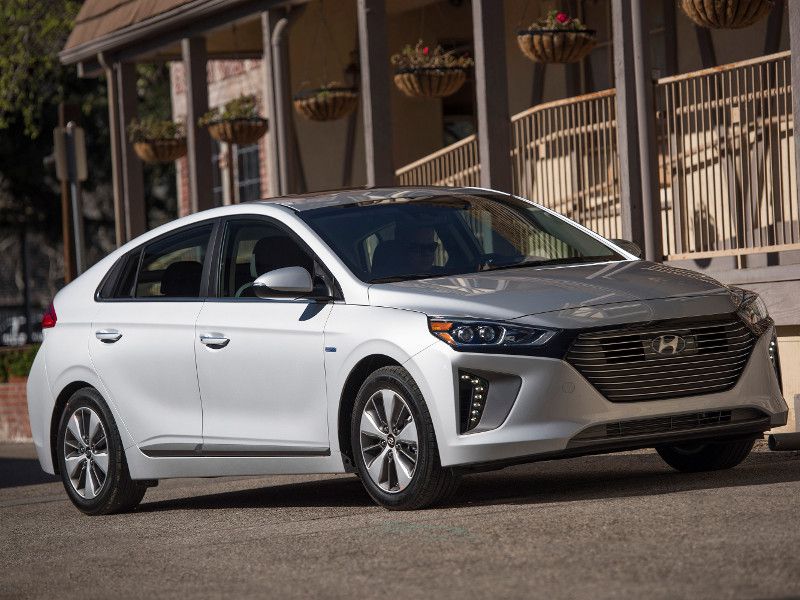
2019 Hyundai Ioniq Plug In Hybrid white driving ・ Photo by Hyundai
Hyundai’s marketing and sales teams have a way with words. On the window sticker of the 2019 Hyundai Ioniq Plug-In Hybrid, they’ve managed to sum up the hatchback’s powertrain technology in two brief sentences: "Electric when you want it. Hybrid when you need it."
Hyundai launched the Ioniq Hybrid against Toyota’s top-selling Prius back in 2017. Last year, it extended the Ioniq’s lineup to include an all-electric model and this plug-in hybrid (PHEV) version. Although plug-in hybrids remain a very small percentage of new car sales, sales are increasing as consumers realize the benefits of the technology — especially as plug-in hybrids offer more range and better driving characteristics than ever before. There are also more models to choose from. Ioniq PHEV competes with a long list of competitors that includes the Chevrolet Volt, Honda Clarity, Kia Niro, and Toyota Prius Prime.
Prices start around $26,000.
The 2019 Hyundai Ioniq Plug-In Hybrid is the Peter Brady of the Ioniq lineup. It costs about $4,000 more than the Ioniq Hybrid and $5,000 less than the Ioniq Electric. Prices start at $26,270, including a $920 fee for destination and handling, which is about $2,000 less than a Toyota Prius Prime.
Built in South Korea, the Ioniq Plug-In Hybrid is offered in two trim levels: base, and the better equipped Limited, which costs $4,000 more. Standard features on the base model include Bluetooth, keyless entry, dual-zone climate controls, cloth upholstery, heated front seats, and a 7-inch touchscreen. All models are front-wheel drive and have a six-speed dual-clutch automatic transmission. Limited models like our test vehicle get leather upholstery, power-adjustable front seats, and more safety features. With options, which included navigation and a sunroof, our test vehicle cost just over $33,000.
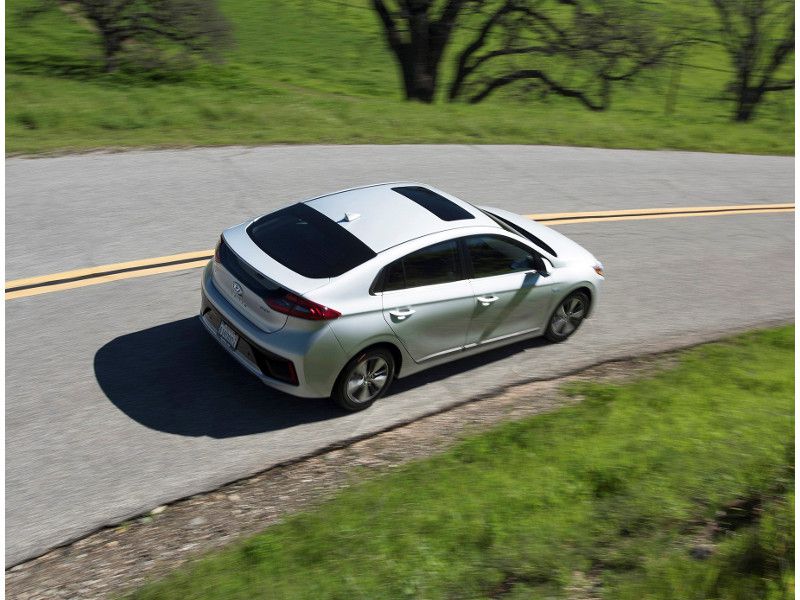
Photo by Hyundai
Its batteries charge quickly.
All 2019 Hyundai Ioniq Plug-In Hybrids are powered by a small 60-horsepower electric motor combined with a 104-hp 1.6-liter four-cylinder gas engine, for a total output of 139 hp. Powering the electric motor is a small 8.9-kWh lithium-ion battery pack, while the gas engine drinks from a large 11.4-gallon fuel tank. The combination gives the Ioniq PHEV a total range of more than 600 miles, which includes 29 miles of all-electric driving.
If the charge of the Ioniq’s battery pack is depleted, Hyundai says it takes two hours and 15 minutes to fully charge the hatchback on a 240-volt charger and nine hours on a conventional 120-volt household outlet. Toyota says the Prius Prime takes the same amount of time to charge on 240-volt power, but only five hours and 30 minutes on 120 volts. During our week with the Ioniq, we charged it only on a 120-volt outlet, plugging it in overnight.

Photo by Hyundai
Less Electric Range Than Some Competitors
Driving the 2019 Hyundai Ioniq Plug-In Hybrid around Los Angeles for a week was enjoyable, and we found its electric range to be just enough most days. Although the Ioniq’s 29 miles of electric range is competitive with the Toyota Prius Prime, the Chevrolet Volt and the Honda Clarity PHEV have significantly larger battery packs and are capable of considerably more. Although the Honda has a total range of just 340 miles, which is much lower than the Hyundai, the EPA says it can go 47 miles on a charge. And with a battery range of 53 miles, the Chevy Volt offers the most electric range in the class and a total range of 420 miles.
During our time with the Ioniq, I was able to drive it between 25 and 27 miles before its batteries were depleted. That’s when its gas engine kicks in to charge the batteries, although it’ll always turn on to add power when you apply the throttle aggressively.
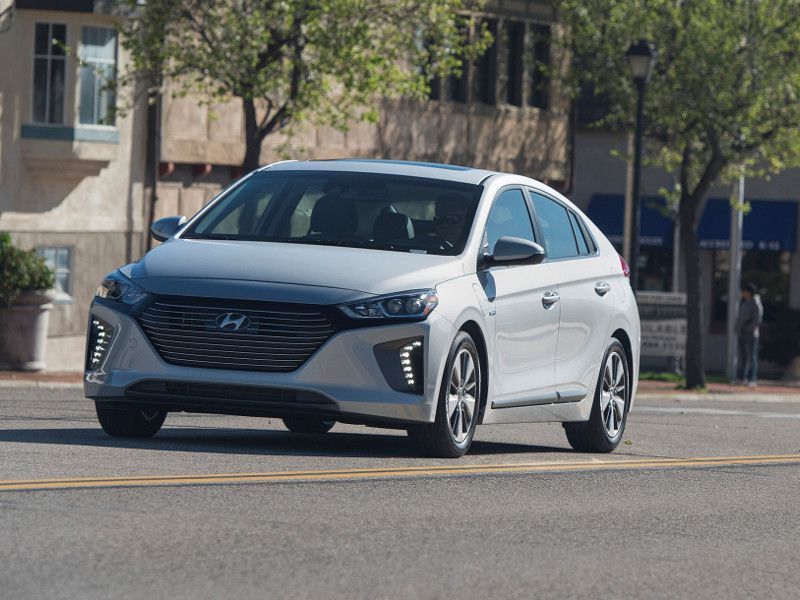
Photo by Hyundai
Easier to Live With Than a Pure Electric
It’s easier to live with a plug-in hybrid than a pure electric car because of the PHEV's flexibility and total range. If its batteries are depleted of charge, you can still drive the Ioniq PHEV on gasoline as far as you may want or need. You just can’t do that with a pure electric. Unless an EV’s batteries are charged, you’re not going anywhere.
When running on electricity alone, the Ioniq’s powertrain is silent and smooth. You can feel and hear when its four-cylinder engine turns itself on and off, but the powertrain is always refined. The Ioniq’s gas engine only turns on when its additional power is required or the electric battery is depleted, although in Sport mode it’s usually running, boosting responsiveness and acceleration at the expense of efficiency. Overusing Sport mode may cost you miles of EV range and overall fuel economy, but the additional power is addictive. I averaged 18 to 22 miles of EV range and 44.3 mpg using Sport mode most of the time.
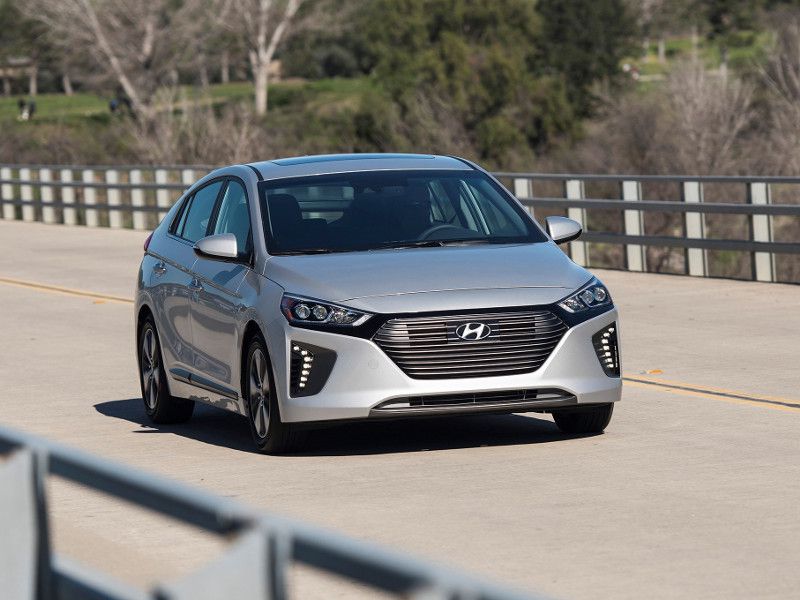
Photo by Hyundai
Not Very Quick, But Fun to Drive
Sport mode makes the Ioniq much more responsive and fun to drive, but it’s still no hot hatch. Floor the throttle when the light turns green, and the Hyundai squeals its front tires and hits 60 mph in about nine seconds. That’s about a second slower than a Chevrolet Volt or Honda Clarity, although it’s a full second ahead of the Prius Prime. Power is sufficient, and merging on the highway is stress-free. Plus, the six-speed automatic performs well, and there are paddle shifters on the leather-wrapped steering wheel if you want to select gears manually.
More impressive is the Ioniq’s handling. With its low center of gravity, the Ioniq likes to change direction. Although its tires are small at just 16 inches in diameter, handling is secure and there’s very little body roll when you push it into a corner. The ride is comfortable, and it cruises effortlessly on the highway. Steering is quick and responsive, but it feels a little video-gamey. Its regenerative braking system — which captures the energy and sends it to the battery pack — provides good stopping power, but the brake pedal feel is a bit wooden.
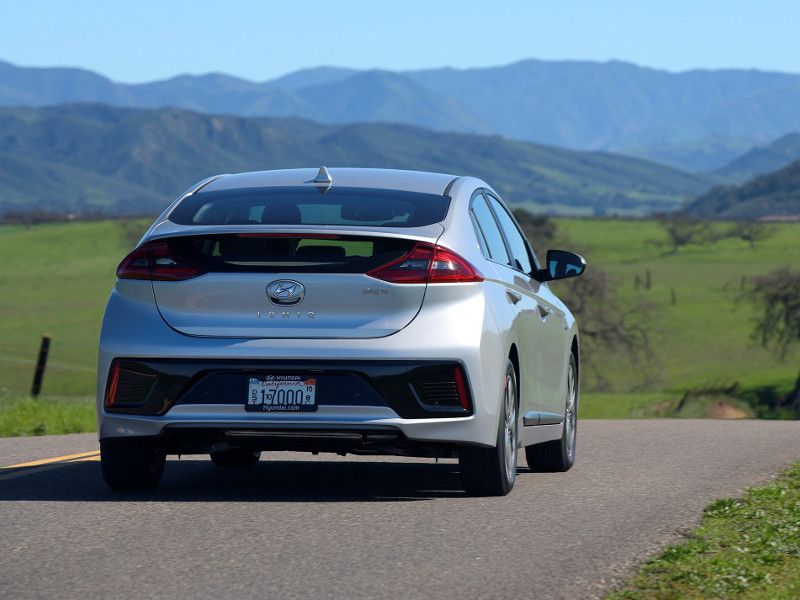
Photo by Hyundai
Attractive Exterior, Comfortable Interior
At 176 inches long and 71.7 inches wide, the 2019 Hyundai Ioniq is 6.9 inches shorter than a Prius Prime, but the Hyundai is a couple of inches wider than the Toyota and an inch lower. This gives the Ioniq an athletic stance on the road, which is visually amplified by its hatchback silhouette. We also like the Ioniq’s large grille that features a three-stage active air flap. It opens when additional cooling and airflow is needed, while otherwise it’s closed to improve aerodynamics.
Inside, the Ioniq has a modern and comfortable interior, with an overall feeling of quality. Panel fitment is precise, and the seats are firm, well-bolstered, and supportive. It has easy-to-use climate controls and a well-placed touchscreen for the infotainment system, which isn’t overly complex and shows sharp graphics. Visibility is excellent thanks to thin A-pillars. Our only gripe is the Ioniq’s old-school foot-operated parking brake. At this price point, it should be with operated with a push-button. In fact, the parking brake is quite a popular topic on ioniqforum.com, but owners say they get used to it quickly.
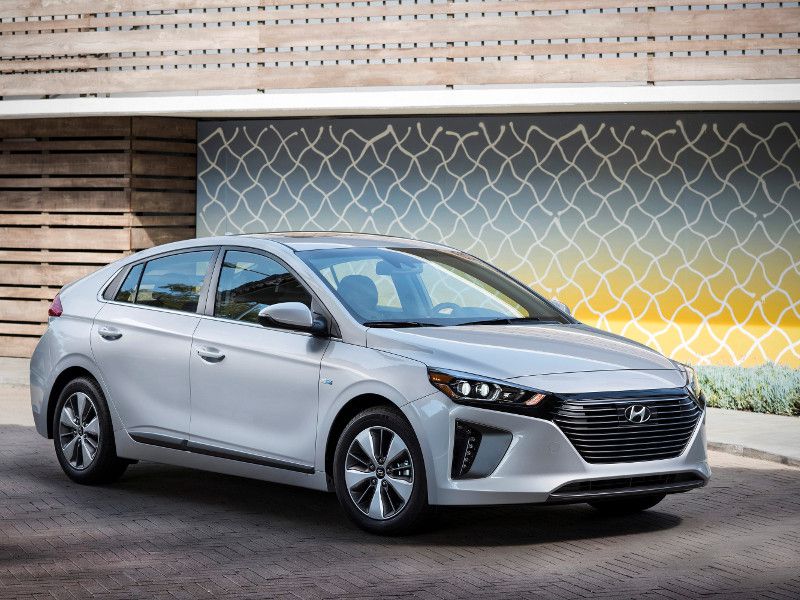
Photo by Hyundai
Spacious, Family-Friendly Interior
The Ioniq’s long 106.3-inch wheelbase, which is the same as the Prius’, gives this hatchback a very large rear seat with considerable legroom. Three adults can sit back there comfortably, and rear seat passengers get their own air-conditioning vents. Plus, the floor is practically flat, so the person in the middle seat isn’t uncomfortably straddling a hump. There’s also plenty of interior storage: The center console bin isn’t huge, but it’s big enough to be useful, and there are sizable door pockets and another bin ahead of the shifter.
Our tested Limited model comes standard with smart cruise control, automatic emergency braking, and lane-keeping assist, while its $2,975 Ultimate Package added rear parking sensors and headlamps that turn with the steering wheel. The Hybrid version of the Ioniq has also been chosen by the Insurance Institute for Highway Safety as a Top Safety Pick.
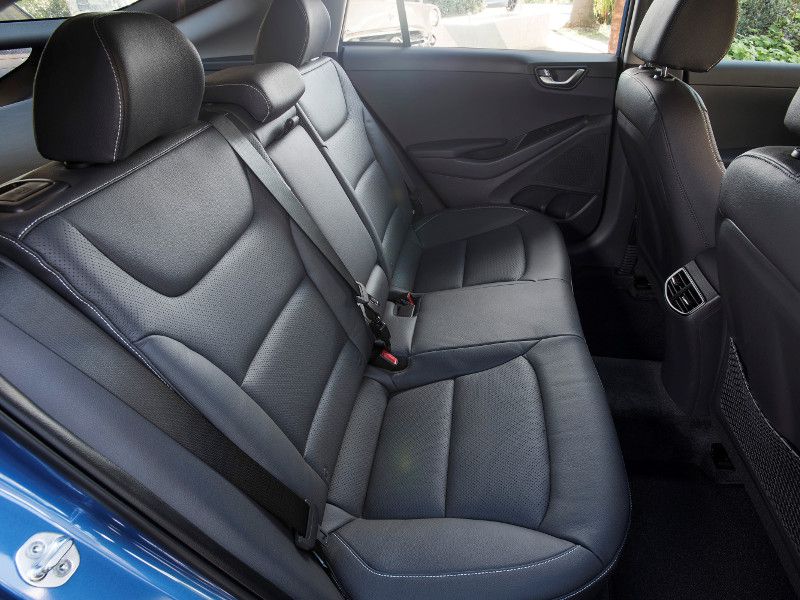
Photo by Hyundai
Lots of Cargo Space and Eco-Friendly Materials
The 2019 Hyundai Ioniq Plug-In Hybrid offers 23 cubic feet of trunk space, which is more than the Toyota Prius Prime and Chevrolet Volt and about the same as the Kia Niro. For larger items, the Hyundai's back seat is split 60/40 and folds flat, which about doubles its cargo capacity. A mountain bike will fit. Unfortunately, a power-operated decklid is not offered.
To construct the Ioniq, Hyundai uses many recycled or ecologically-sensitive materials. For instance, the interior door covers are made of plastic combined with powdered wood and volcanic stone, while the raw materials extracted from sugar cane are applied on the headliner and carpet.
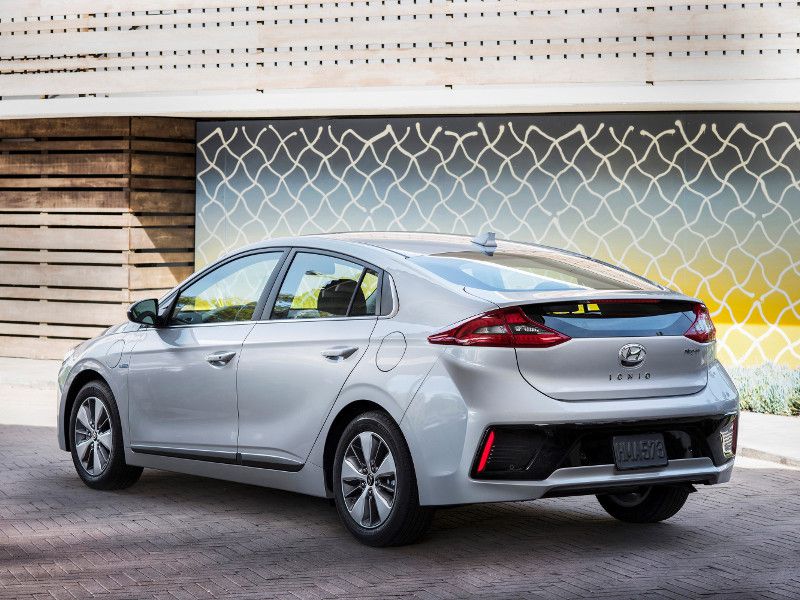
Photo by Hyundai
Final Thoughts
Buyers should also know that the Hyundai Ioniq is a mechanical twin to the Kia Niro, which is also available as a plug-in hybrid. Hyundai and Kia are owned by the same company, which uses the same powertrain technology in both vehicles. The two cars provide about the same range and overall performance, though the Kia costs a bit more and offers more rugged SUV-esque styling.
Overall, the 2019 Hyundai Ioniq Plug-In Hybrid is a compelling package, offering a desirable combination of range, comfort, spaciousness, and value. It also performs well and it’s fun to drive. If you drive less than 30 miles a day, you can drive this car for months using just a few drops of gasoline. If you’re looking for a plug-in hybrid hatchback, it's a very desirable choice.
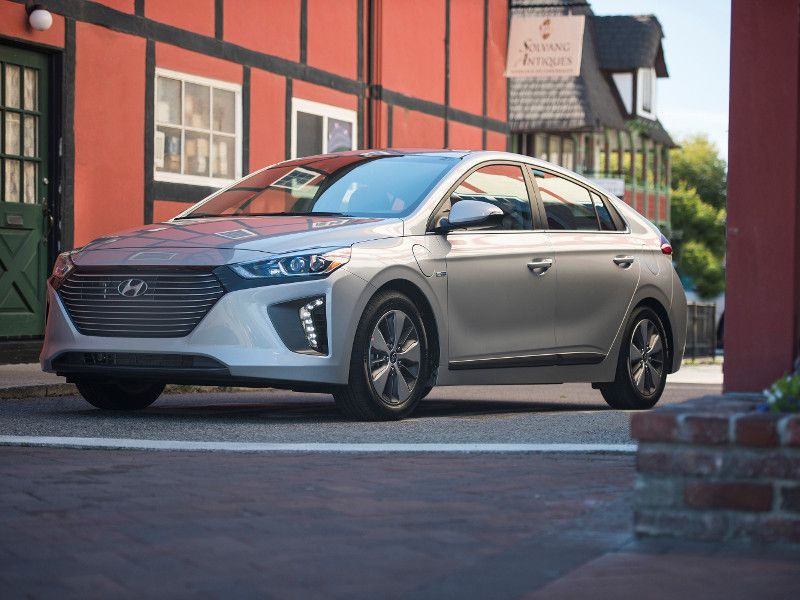
Photo by Hyundai